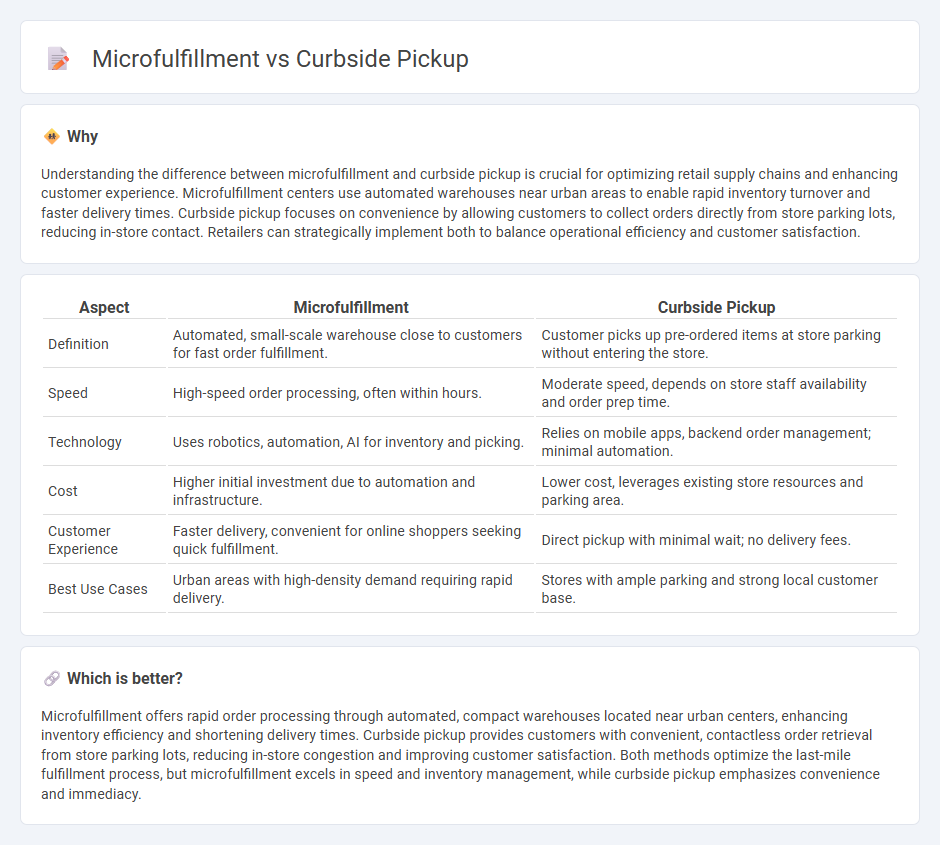
Microfulfillment centers use automated technology to efficiently process online orders within urban areas, reducing delivery times and lowering fulfillment costs. Curbside pickup allows customers to order online and collect purchases directly from store parking lots, enhancing convenience and minimizing in-store contact. Explore how these retail strategies transform customer experience and operational efficiency.
Why it is important
Understanding the difference between microfulfillment and curbside pickup is crucial for optimizing retail supply chains and enhancing customer experience. Microfulfillment centers use automated warehouses near urban areas to enable rapid inventory turnover and faster delivery times. Curbside pickup focuses on convenience by allowing customers to collect orders directly from store parking lots, reducing in-store contact. Retailers can strategically implement both to balance operational efficiency and customer satisfaction.
Comparison Table
| Aspect | Microfulfillment | Curbside Pickup |
|---|---|---|
| Definition | Automated, small-scale warehouse close to customers for fast order fulfillment. | Customer picks up pre-ordered items at store parking without entering the store. |
| Speed | High-speed order processing, often within hours. | Moderate speed, depends on store staff availability and order prep time. |
| Technology | Uses robotics, automation, AI for inventory and picking. | Relies on mobile apps, backend order management; minimal automation. |
| Cost | Higher initial investment due to automation and infrastructure. | Lower cost, leverages existing store resources and parking area. |
| Customer Experience | Faster delivery, convenient for online shoppers seeking quick fulfillment. | Direct pickup with minimal wait; no delivery fees. |
| Best Use Cases | Urban areas with high-density demand requiring rapid delivery. | Stores with ample parking and strong local customer base. |
Which is better?
Microfulfillment offers rapid order processing through automated, compact warehouses located near urban centers, enhancing inventory efficiency and shortening delivery times. Curbside pickup provides customers with convenient, contactless order retrieval from store parking lots, reducing in-store congestion and improving customer satisfaction. Both methods optimize the last-mile fulfillment process, but microfulfillment excels in speed and inventory management, while curbside pickup emphasizes convenience and immediacy.
Connection
Microfulfillment centers enable rapid order processing by using automated storage and retrieval systems close to urban consumers, significantly reducing delivery times. Curbside pickup leverages these centers to provide customers with quick, convenient access to online orders without entering stores. Together, they optimize inventory management and enhance last-mile fulfillment efficiency in the retail sector.
Key Terms
Last-Mile Delivery
Curbside pickup offers a convenient last-mile delivery solution by allowing customers to collect orders directly from store parking lots, reducing delivery time and operational costs. Microfulfillment centers, strategically located near urban areas, enhance efficiency by automating order preparation and enabling faster, lower-cost home deliveries. Explore how combining these strategies can optimize last-mile logistics and improve customer satisfaction.
Order Fulfillment
Curbside pickup streamlines order fulfillment by enabling customers to collect purchases directly from retail locations, reducing in-store congestion and enhancing convenience. Microfulfillment centers optimize order accuracy and speed through automated systems situated close to urban customers, supporting same-day delivery and minimizing last-mile logistics costs. Explore how these distinct strategies can transform your supply chain efficiency and customer satisfaction.
Inventory Management
Curbside pickup relies heavily on accurate real-time inventory updates to ensure product availability at store locations, minimizing order errors and customer dissatisfaction. Microfulfillment centers utilize automated systems and robotics to efficiently manage inventory in smaller, urban warehouses, enabling faster order fulfillment and reduced stockouts. Explore how integrating both strategies can optimize your inventory management and enhance customer experience.
Source and External Links
Curbside Pickup - The Home Depot - Customers can select curbside pickup at checkout for eligible items, receive notification when orders are ready, check in via app, and have orders brought out to their vehicle at designated parking spots, available daily from 9 a.m. to 6 p.m. at select stores.
Curbside Waste & Recycling Program - Portsmouth, RI - The town provides curbside collection of trash, recycling, and yard waste with specific guidelines on cart placement by 6 a.m. on collection days and space between carts, collected weekly for an annual fee.
Curbside Recycling & Garbage - Alachua County - Residents must place waste and recycling carts curbside by 7 a.m. on pickup day, with options to choose different cart sizes and services including free bulk item pickup by scheduling with the waste collection office.
 dowidth.com
dowidth.com